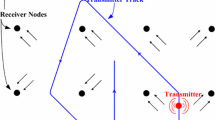Abstract
In this paper, the problem of spectrum status determination is considered for large cognitive radio (CR) ad hoc networks. Spectrum sensing and spectrum decision are critical for cognitive radio network throughput and hence obtaining accurate knowledge of the spectrum status is vitally important to better spectrum usage decisions. The major challenge of this type of problem lies in the fact that for a network covering a large geographical area, only very limited measurements of spectrum occupancy during spectrum sensing may be obtained by the CR users for a certain location in any given time slot. This is due to both the hardware limitations as well as the tradeoff between spectrum sensing time and data throughput of the CR users. By representing the spectrum sensing results across the network as an image, spectrum status determination is formulated as an image recovery problem. The method of total variation inpainting is applied to solve the problem with low determination error. The proposed method takes advantage of the correlations in multiple dimensions and the numerical results demonstrate the effectiveness of the proposed scheme.





















Similar content being viewed by others
References
Zeng, Y., Liang, Y.-C., Hoang, A. T., & Zhang R. (2010). A review on spectrum sensing for cognitive radio: Challenges and solutions. EURASIP Journal on Advances in Signal Processing 2010, 381465. doi:10.1155/2010/381465.
Yucek, T., & Arslan, H. (2009). A survey of spectrum sensing algorithms for cognitive radio applications. IEEE Communications Surveys and Tutorials 11(1), 116–130.
E. R. LLC, USRP2— the next generation of software radio systems [online], http://www.ettus.com/downloads/ettus_ds_usrp2_v2.pdf.
Liang, Y.-C., Zeng, Y., Peh, E., & Hoang, A. T. (2008). Sensing-throughput tradeoff for cognitive radio networks. IEEE Transactions on Wireless Communications, 7(4), 1326–1337.
Chiang, R., Rowe, G., & Sowerby, K. (April 2007). A quantitative analysis of spectral occupancy measurements for cognitive radio. IEEE Vehicular Technology Conference (VTC) 2007-Spring, pp. 3016–3020.
Candes, E., & Recht, B. (2009). Exact matrix completion via convex optimization. Foundations of Computational Mathematics 9, 717–772.
Keshavan, R., Oh, S., & Montanari, A. (2009). Matrix completion from a few entries. ISIT.
Recht, B., Fazel, M., & Parrilo, P. Guaranteed minimum rank solutions of matrix equations via nuclear norm minimization. SIAM Review.
Li, H. (May 2010). Reconstructing spectrum occupancies for wideband cognitive radio networks: A matrix completion via belief propagation. IEEE International Conference on Communications (ICC), pp. 1 –6.
Chan, T., & Shen, J. (2001). Mathematical models for local non-texture inpaintings. SIAM Journal of Applied Mathematics, 62(3), 1019–1043.
Oppenheim, A. V., & Schafer, R. W. (1989). Discrete-time signal processing. Upper Saddle River, NJ: Prentice-Hall.
You, Y.-L., & Kaveh, M. (1996). A regularization approach to joint blur identification and image restoration. IEEE Transactions on Image Processing, 5(3), 416–428.
Goldstein, T., & Osher, S. (April 2009). The split bregman method for l1-regularized problems. SIAM Journal on Imaging Sciences, 2, 323–343. [Online]. Available: http://portal.acm.org/citation.cfm?id=1658384.1658386.
Getreuer, P. (Nov 2009) tvreg: Variational imaging methods for denoising, deconvolution, inpainting, and segmentation. downloadable with MATLAB source code at: http://www.mathworks.com/matlabcentral/fileexchange/25997-tvreg-variational-imaging-methods.
Coughlan, J. (Aug 2009). A tutorial introduction to belief propagation. slides.
Szeliski, R., Zabih, R., Scharstein, D., Veksler, O., Kolmogorov, V., Agarwala, A. et al. (2008). A comparative study of energy minimization methods for markov random fields with smoothness-based priors. IEEE Transactions on Pattern Analysis and Machine Intelligence, 30(6), 1068–1080.
Keshavan, R. H. & Oh, S. (2009). A gradient descent algorithm on the grassman manifold for matrix completion. CoRR, vol. abs/0910.5260.
Perez-Romero, J., Sallent, O., & Agusti, R. (2009). On the applicability of image processing techniques in the radio environment characterisation. IEEE Vehicular Technology Conference (VTC) 2009-Spring, pp. 1–5.
Bolea, L., Pérez-Romero, J. , Agustí, R., & Sallent, O. (2009). Primary transmitter discovery based on image processing in cognitive radio. Proceedings of the 15th open European summer school and IFIP TC6.6 workshop on the internet of the future, ser. EUNICE ’09. Berlin, Heidelberg: Springer, pp. 178–187.
Ganesan, G., Li, Y., Bing, B., & Li, S. (2008). Spatiotemporal sensing in cognitive radio networks. IEEE Journal on Selected Areas in Communications, 26(1), 5–12.
Donoho, D. (2006). Compressed sensing. IEEE Transactions on Information Theory, 52(4), 1289–1306.
Baraniuk, R., Candes, E., Nowak, R., & Vetterli, M. (2008). Compressive sampling [from the guest editors]. IEEE Signal Processing Magazine, 25(2):12–13.
Candes, E., & Romberg, J. (2007). Sparsity and incoherence in compressive sampling. Inverse Problems, 23(3), 969.
Ghasemi, A., & Sousa, E. (Nov 2005). Collaborative spectrum sensing for opportunistic access in fading environments. First IEEE International Symposium on New Frontiers in Dynamic Spectrum Access Networks, pp. 131–136.
Potier, P., & Qian, L. (2011). Network management of cognitive radio ad hoc networks. CogART’11, pp. 33–38.
Acknowledgments
The first author is supported by the US National Science Foundation (NSF) Graduate Research Fellowship. This research work is supported in part by NSF under CNS-1040207, ECCS-0901425, and the US Army Research Office under Cooperative Agreement W911NF-12-1-0054.
Author information
Authors and Affiliations
Corresponding author
Rights and permissions
About this article
Cite this article
Potier, P., Sorrells, C., Wang, Y. et al. Spectrum inpainting: a new framework for spectrum status determination in large cognitive radio networks. Wireless Netw 20, 423–439 (2014). https://doi.org/10.1007/s11276-013-0614-9
Published:
Issue Date:
DOI: https://doi.org/10.1007/s11276-013-0614-9




